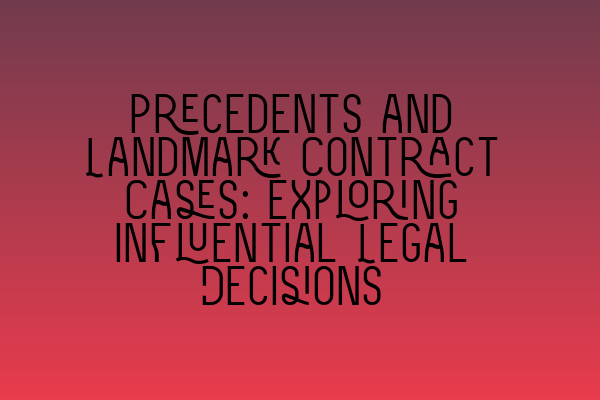Precedents and Landmark Contract Cases: Exploring Influential Legal Decisions
Contract law is a fundamental aspect of legal practice and plays a crucial role in regulating commercial transactions and relationships. Within contract law, there are numerous precedents and landmark cases that have shaped the interpretation and application of contractual principles. In this article, we will delve into some of these influential legal decisions and their significance in contract law.
The Doctrine of Precedent
The doctrine of precedent, also known as stare decisis, is a fundamental principle of English law that ensures consistency and stability in the legal system. It means that courts are bound to follow the decisions of higher courts, creating a hierarchy of legal authority. Precedents establish legal principles and provide guidance for future cases.
One significant contract law precedent is Hadley v Baxendale. This landmark case established the principles of remoteness and foreseeability of damages in contract law. It held that a party can only recover damages for losses that were reasonably foreseeable by both parties at the time of contract formation.
Contract Formation and Interpretation
When it comes to contract formation and interpretation, several influential cases have shaped the understanding of key concepts. Consider Carlill v Carbolic Smoke Ball Co, which clarified the concept of unilateral contracts. This case held that an advertisement could constitute an offer, and acceptance could be demonstrated through performance of the requested act.
Another critical case in contract interpretation is McCutcheon v David MacBrayne Ltd, which established the contra proferentem rule. This rule states that any ambiguity or uncertainty in a contract is construed against the party that drafted it. It places the burden of clarity on the party with greater contractual expertise.
Implied Terms and Exclusion Clauses
Contracts often contain implied terms and exclusion clauses, which may limit or exclude liability between the parties. Spurling v Bradshaw is a landmark case that dealt with the interpretation of exclusion clauses. It held that exclusion clauses must be adequately brought to the attention of the other party, and any ambiguity should be construed against the party seeking to rely on the clause.
Another noteworthy case is The Merchant of Prato, which explored the implication of terms based on previous dealings. It highlighted that terms may be implied into a contract if they are necessary for the reasonable efficacy of the contract or reflect the intentions of the parties.
Impact on Contract Law
These precedents and landmark contract cases have had a significant impact on contract law as a whole. They have provided clarity on key principles, enhanced the understanding of contract formation and interpretation, and influenced how contractual terms are implied and exclusion clauses are interpreted.
Lawyers and solicitors must be familiar with these influential decisions to effectively advise their clients and navigate the complexities of contract law. By studying these cases, legal professionals can strengthen their argumentation, negotiate favorable terms, and ensure compliance with contractual obligations.
Conclusion
Precedents and landmark cases in contract law serve as guiding pillars in legal practice. They shape the interpretation of contractual principles, establish important doctrines, and provide invaluable insights into the development of contract law. As legal professionals, it is essential to stay abreast of these influential legal decisions and their subsequent impact on the field of contract law.
To enhance your understanding of contract law and prepare for the SQE exams, consider exploring our related articles:
- SQE 1 Practice Exam Questions
- SQE 1 Practice Mocks FLK1 FLK2
- SQE 2 Preparation Courses
- SQE 1 Preparation Courses
- SRA SQE Exam Dates
With a solid understanding of precedents and landmark cases, you can elevate your legal practice and excel in contract law.
